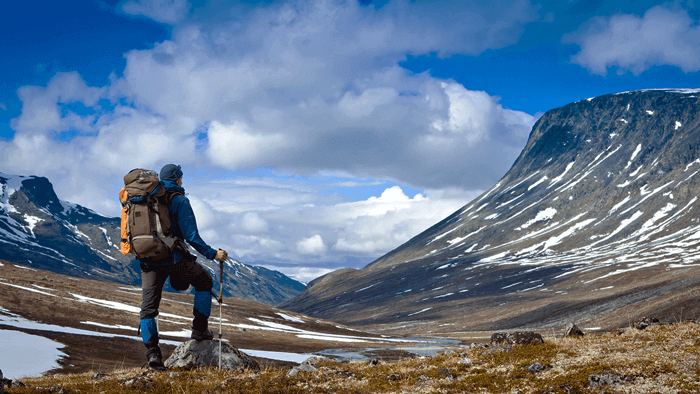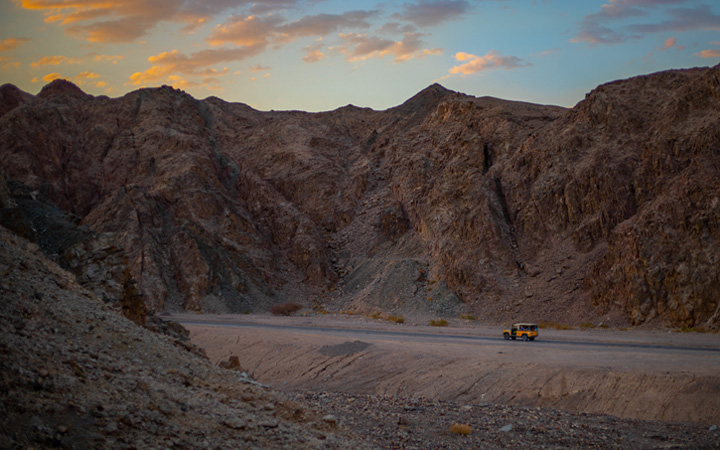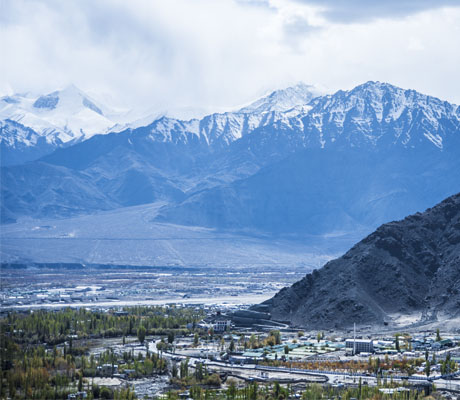All you need to know about Zanskar Valley
Lies to the south –west of Ladakh, Zanskar often referred to as ‘Country of Dharma’. The region being associated with Guru Padmasambhava and the great yogi Naropa has the Buddhist majority. The region is a part of Kargil district and Zanskar is the only Buddhist majority sub-region, which has otherwise about 85% Muslim population. Zanskar valley is the most isolated of all the regions of Ladakh. Entire Zanskar is in fact a trekker’s paradise.How to reach Zanskar Valley
The road that links Kargil and Padum also remain cut-off for about six to eight months in a year. The region does not have any air link with other parts of the country, except for emergency purpose. From July to October, in the peak tourist season taxis may be hired from Kargil. Bus services on the route are also available from Leh or Kargil. The schedule of buses can be checked locally.
Padum (3505m)
Once the capital of Zanskar, Padum is today administrative headquarter of the region. Padum is a wide plain where two rivers; Stod from north-west and Tsarap river from south-east meet to form Zanskar river which flows towards north to join the Indus at Nimmo. It is on this Zanskar River, famous Chaddar trek (walking on the frozen river ) is carried out in winter. The same frozen trek also serves as a communication line to the people living in Zanskar. There are many small villages scattered in Zanskar region, some of the monasteries here are quite well known. But since many of the villages in the region are not linked by road, approach to these monasteries is only available on foot. Some of the monasteries which have road link are: Karsha, about 9km from Padum is known for the largest Gelugpa monastery of Zanskar. It is situated on the base of the hill with a beautiful view of whole Padum valley. Stongde monastery, about 18 km away from Padum is situated high on a hill which gives a panoramic view of the region. It is the second largest Gelugpa monastery in Zanskar. Bardan monastery is 12km away from Lungnak valley.
.jpg)
Zanskar Circuit: Leh-Padum (474 km)
Kargil to Padum for about 240km is almost a mud track throughout the stretch. Make sure you are well prepared with your basic necessity, including fuel for your return trip. For about first 100 km of the journey, the road meanders through the Suru valley. The suru valley was once considered to be the granary of Ladakh. The scenic beauty of the green valley amply compensates you for the inconvenience of your bumpy ride. The road remains open from around July to October and may even stretch to December depending upon the weather. If you are travelling direct from Leh, a night stay at Kargil is recommended. However, pushing further into the suru valley, even upto Panikhar will be more logical. In case you want to do the journey at leisure you may break for the night at Rangdum, but that means one more day.
Kargil-Panikhar/Parkachik (67/90 km): From Kargil you return south about 40 km ahead, the first major village is Sankoo (2960m). There are several little shops and restaurants. The off-shoot valley to the east, across the Suru River, is the Kartse valley. Kartse kharon the mouth of the valley has a 7 m tall sculpture of the future Buddha of 7-8th century. There is a shrine of Sayed Mir Hashim, a 16th century scholar. After about 25 km is another village Panikhar(3180m), situated under the shadow of the nun kun massif. Panikhar along with Parkachik is the base for expedition to Nun Kun peaks. Just before Parkachik you cross the young Suru River to its right. From village Suru there is another road to village Parkachik which runs on the right of the Suru River.
Information on Panikhar and Parkachik: It is a base station for undertaking mountaineering expedition to the various Himalayan peaks surrounding the valley, but too early for the night halt on way to Zanskar. Tourist rest house and a tourist bungalow are available at Suru. There is another tourist bungalow at Panikhar. There is couple of restaurants and shops with basic necessity. Taxi and busses for kargil are available here. Parkachik(3450m) 20km further from panikhar is the perfect base for trekking and expedition in the Nun-Kun area. There is a tourist hut, and a PWD rest house. However amenities like shop, hotel or restaurant are lacking.
Parkachik-Rangdum(43km): Parkachik is about 20 km from Panikhar. Here you can see the mighty Parkachik glacier disappearing in the Suru River. From Parkachik about 20km, you reach the first major village of Zanskar, Rangdum(3657m) situated in the midst of large alluvial plain, surrounded by beautiful peaks.
Rangdum: Although the hamlet itself is collection of few houses, the monastery in the center of the wide plain is impressive. This is an 18th century Buddhist monastery of Gelugpa order. Rangdum is also the base for major trekking routes in the area. There is tourist complex and some guest houses too, if you do not wish to tent in the ethereal ambience of the beautiful valley. There is also a police check-post. No shops, except a tea stall which may provide food on demand.
Rangdum to Karsha(112 km): From Rangdum it is about 25 km to Pensi la pass(4400m) which forms the watershed of Stod and Suru rivers, the tributaries of river Indus. Right on the pass is two small lakes and a solitary chorten. From this point you can have the view of magnificent Drang-Drung glacier, which looks as if in motion. After Siachen, it is the second largest glacier in Ladakh. After crossing Pensi la, you enter the Zanskar valley. From here start the last stretch of about 90 km road, which runs along the Stod or Doda River, leading to Padum. There are several tiny hamlets; the interesting ones are Himilung, Phe, Rantaksha and Rimala. One should make a detour to visit Dzongskul monastery, situated in the gorge of tributary of the Doda river which descends opposite to the village of Phe. At Tungri you cross the Stod and enters Sani village.
Information: Padum(3505m) is in fact a point where trekker end or start their journey. There are sufficient hotel and restaurants to cater to the small number of tourist which come at this far flung place. Enough camping sites are available on the wide green plains. There is also a market, where you can buy some of your basic goods if planning a trekking, but do not expect everything. Amenities include local taxis, phone, police post, post office, a tourist bungalow. There are also a couple of travel agents who can arrange you ponies, guides and other services. Bus services from Padum to nearby villages are also available. There is a helicopter service available at Padum in emergencies. Zangla is a nodal point on the popular Padum, Tongdey Zangla, Karsha, Padum round trip which covers most of the cultural sites of Zanskar. The old rope suspension bridge spanning the tumultuous Zanskar River near Zangla, a rare feat of folk engineering, still exists, though no more in use. The river is now crossed by foot bridge, to reach Karsha. Zangla is also the take off point for the Padum-Lamayuru and the Padum-Markha valley trek. There is a road under construction into the Lungnak valley, last time it was motorable upto Ichar village. It is just a day walk upto Phugtal. There is 8th century rock cravings scattered on the upper side of the Padum town. One on a big boulder on the bank of the Tsarap stream is impressive.
Monasteries in Zanskar Valley
Rangdum Gonpa: The small fortified monastery perched on a small mound in the middle of the vast green plain is impressive in its own right. The main gateway leads to a small courtyard with a chorten in the middle and with monk’s quarters on the side and dukhang in the front. As usual it has rows of seats with an Avalokiteshvara and that of Geleg Yeshe Takpa. A smaller room has an image of Shakyamuni Buddha and Tsongkhapa. The gohkhang as the protector deites. A small museum has a various collection of seemingly old thangkas, arms, manuscript and a collection of fossils of many ancient marine animals which apparently were unearthed during the digging at monastery.Sani Gompa: It is famous for its monastery and particularly the stupa that is claimed to be the oldest in Ladakh. This stupa is believed to have been constructed during Kushan period. There is a myth associated with this stupa as some person believed that it was magically constructed by the force of Ashoka’s prayer. Sani monastery itself was constructed during the reign of Deskyong Namgial(1729-39). Guru Padmasambhava and Naropa is said to have visited Sani. The whole complex is surrounded by walls. The gonpa consist of a huge multi-columned central prayer hall housing an array of statues of popular Buddhist divinities and Drukpa saints. The main image is of Shakyamuni, on either side are rows of images, namely four armed Avalokiteshvara and the Buddhas of the past, present and future, and eleven headed Avalokiteshvara and Padmasambhava. Interesting frescoes, however, can be seen in a small, almost discarded temple room at the back of the main building, whose walls are adorned with stucco murals of Shakyamuni, several lamas, and different manifestation of Padmasambhava.
Zangla Temple: It is located in a ruined fort above the village. The temple may not seem significant unless we don’t throw some light on its history. In one of its tiny room, Hungarian scholar, Csoma De Koros spent his winter in 1823. He became the first European to study Tibetan systematically and regarded as the founder of modern Tibetology. In 2011, we saw more than a dozen Hungarians renovating this fort and the room where Csoma stayed.
Zongskul Gompa: Zongskul also has a spectacular cave monastery and falls on the Padum-Kishtwar trail. The monastery is situated like a swallow’s nest on the rock face of the Ating gorge. It is said to be founded by Naropa, who meditated in a cave above monastery. A footprint on the rock near ingress of the lower cave is revered as that of the yogi. The cave also has a statue of Naropa and one of Vajradhara. The frescos on the cave walls are very old and reflect a high degree of artistic achievement. There are various thangkas of interest.
Karsha Gompa: It is the largest Gelukpa Gompa in Zanskar, situated on a steep gradient of the mountain base, overlooking the valley up to Padum. The entire complex has number of temple rooms and only some of the major ones are mentioned here. The courtyard has approaches to two halls, the dukhang on the western side and dukhang yokmaon the eastern. The monastery is associated with Phagspa Shesrab, the Zanskar Lotsava of 11th century, but the monastery itself dates back to 15th century when Gelukpa order was introduced. The main Dukhang has number of images including Sakyamuni buddha, Tsongkhapa and Dorje shugdan. The lower dukhang contains a statue of Maitreya and Tibetan canon on the left side along with images of Sakyamuni, Amitabha, Vijaya, Tara. The wall painting depicts scenes from life of Sakyamuni Buddha, Availokiteshvara, Tara and Manjushiri. The Gonkhang is next to the Dukhang. The images include a wooden Tsonkhapa. On the right side is a group of divinities particularly of gelukpa order. It also include Vaisvaravana and Dhrirarashtra. These include Paldan Lamo(sri devi), six-armed mahakala, Dharmaraja, Vajrabharava, white guardian. The wall paintings include: to the left of entrance; Vijaya(Namgyal ma), four armed Mahakala, Vajrapani and Hyagriya. The left wall has Buddhas and Bodhisattavas. The Kanjur lakhang containing holy books with Tsonkhapa, Tara, Manjushiri etc on the walls. Another temple contains statues of Tsonkhapa with his two disciples. The other temple room include: Labrang with a statue of Maitreya and Avalokiteshvara. The mural, considered one of the best depicts five different manifestation of buddha and prajnaparamita. Maitreya’s temple at the lower end has an mural of maitreya and in the front of the statue of Availokiteshvara. The wall has Tsonkhapa, Padmasambhava, Dharmaraja, Sakyamuni Buddha and the four kings of the quarters near the door. A separate temple of eleven-headed Availokiteshvara is on a hillside below the old fort. This is one of the best surviving temples in Zanskar.
Stongday Gompa: About 20 km from Padum, the monastery is situated on a small hill giving a commanding view of the entire valley below. The gompa, founded by Marpa, is the second largest monastic establishment of Zanskar belonging to Gelukpa order.
Phugtal Gompa: It is considered to be the most spectacularly located monastery in Ladakh. There is a jeepable tract up to Reru. From there, it is a couple of days trek. The place is worth a visit not only for its monastery, but for the Zanskari’s austere lifestyle. It is perhaps the most isolated monastic establishment of Zanskar, and may date back to 11th century. The monastery is situated picturesquely at the mouth of large cave above the right bank of the river Tsarap. The buildings seem to hang from the cliff face around the lip of the majestic cavern opening over the picturesque gorge. One of the chapel, among the several of which it is composed, has frescos and ceiling decorations reflecting strong Indian artistic and iconographic influence. These frescos are almost contemporaneous to those at Alchi monasteries. The Kanjur lakhang contains block-prints, with murals of Manjushiri, Sakyamuni and Tsongkhapa on the walls. The Tonpa lakhang has the murals resembling decoration of tabo, of Indian and Kashmiri inspiration. On the wall are Tsongkhapa surrounded by Buddha and lamas, Bhaishajyaguru, Vajrapani, Guhyasamaja and four armed Avalokiteswara, Green Tara and white guardian. The central image is of Sakyamuni. The Gonkhang has protective deities. There is also an assembly hall and a Maitreya temple with two meter high statue.
Bardan Gompa: The village is situated 12 km south of Padum and the monastery is an isolated one of Drukpa order. It is perched atop a rocky crag, rising vertically from the Lugnak river bed. The monastery was founded in the 17th century as the first ever centre of the old, unreformed Drukpa monastic order in Zanskar. Bardan controls several other smaller Drukpa monasteries, including Sani monastery. The large dukhang in the centre contains beautiful statues of Buddhist divinities and small stupa made of clay, bronze, wood and copper.
Send us query
We will revert in 1hrs
Plan Your Travel
Top Trending Tours
-
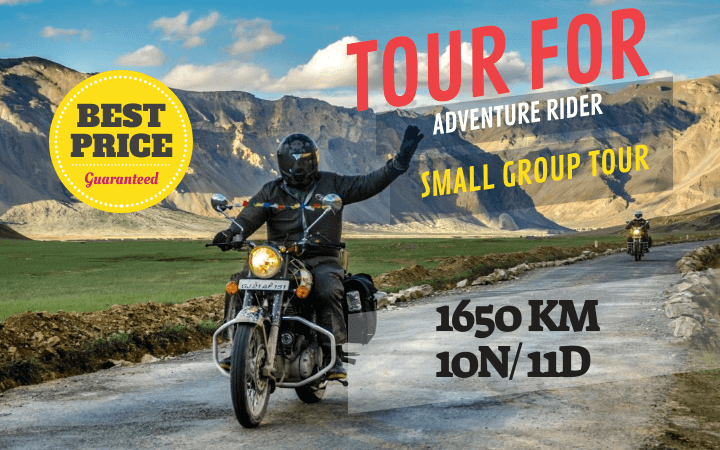
Bike Group tour Manali ladakh manali
Why travel with Ladakh Motor Bike group Tour Ex Ma...
Read More -
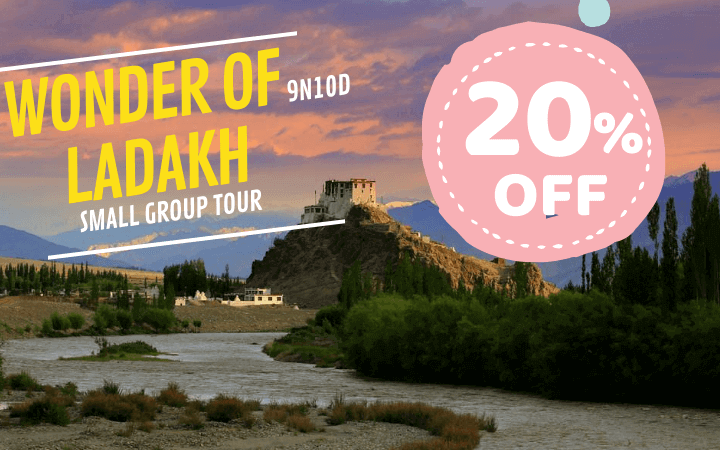
-

Ladakh Delight with Siachen flight included
We welcome you to explore Ladakh Region knowing y...
Read More -

Ladakh Kashmir Manali bike trip Siachen base
Small group motorcycle tours operator since 2014 ...
Read More -

Manali Ladakh Srinagar with tsomoriri & Hanle
Welcome Manali -Srinagar Bike small group trip , t...
Read More


